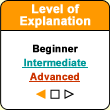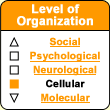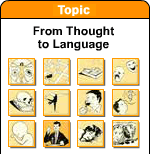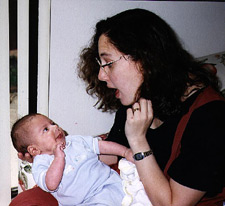|
|
|
|
 |
Communicating in Words |
 |
|
|
|


Eight
Problems with Mirror Neurons
The premotor
cortex, located directly
forward of the motor cortex in the brain’s frontal lobes,
activates certain neurons that cause certain muscle groups
in the body to contract to produce a given action. We now
know that the mirror neurons in the premotor cortex that are
activated to produce such an action are also activated in
a person who is simply watching someone else perform this
same action.
For example, when a baby sees her father stick out his tongue,
the mirror neurons corresponding to this movement in her premotor
cortex are activated. The result is a priming effect that
is strong enough for these same neurons to be activated more
readily a moment later. These neurons then in turn activate
specific neurons in the primary
motor cortex, which trigger the muscles that
cause the baby to stick out her own tongue. |
|
|
| ARE MIRROR NEURONS THE BASIS FOR COMMUNICATION? |
|
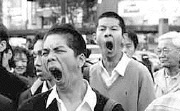 |
For a baby to stick out its tongue is
no easy task. But if you stick out your tongue in front of
a baby, chances are very good that the baby will successfully
imitate you spontaneously. A similar phenomenon can be seen
in adults as well: watch how often, when one person yawns,
the person next to them irresistibly winds up yawning too. |
The underlying cause of these imitation phenomena might well be
a population of neurons known as “mirror
neurons” (see sidebar). In the early 1990s, researchers
working with monkeys identified a group of neurons in their frontal
cortex that were activated when the monkeys made a particular motion
with their hand or mouth. There was nothing surprising in that,
since these neurons were located in what is considered a “motor” portion
of the brain. What was surprising, though, was that this same group
of neurons were also activated in monkeys who were not performing
the motion themselves, but rather watching other monkeys perform
it. Hence these neurons were given the name “mirror neurons”.
The part of the brain where these mirror neurons are found in monkeys corresponds
to the part of the human brain known as Broca’s
area, which since the 19th century has been known to play an important role
in language. In addition to their being located in a brain area associated with
language, two other things about mirror neurons have led many researchers to
suggest that they may play a role in the evolution and learning of language:
these neurons tell us about the intentions of the people around us, and they
help us to imitate the movements of other people’s lips and tongues.
| Though we may associate
language more with sounds than with movements, speech is first
and foremost a motor activity. When we watch small
children speaking their first words by imitating an adult,
we see that they are not just copying sounds, like a parrot.
Instead, they rely much more on the “gestural”
aspect of speech—the way the adult’s mouth moves
as it pronounces the words, rather than the acoustic features
of the sounds coming out of it. |
|
To some researchers, it seems increasingly
apparent that it is this motor aspect of new words that makes it
so easy for babies to imitate them, and that these “imitation circuits” in Broca’s
area operate through the mirror neurons located there. Mirror neurons
have several
other amazing characteristics as well.
|
|

